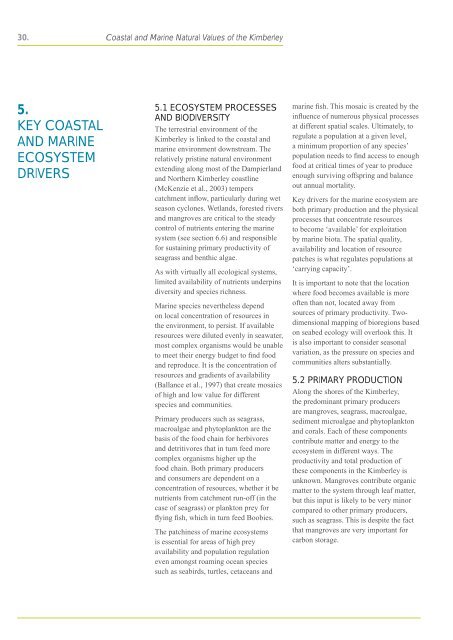coastal and marine natural values of the kimberley - wwf - Australia
coastal and marine natural values of the kimberley - wwf - Australia
coastal and marine natural values of the kimberley - wwf - Australia
You also want an ePaper? Increase the reach of your titles
YUMPU automatically turns print PDFs into web optimized ePapers that Google loves.
30. Coastal <strong>and</strong> Marine Natural Values <strong>of</strong> <strong>the</strong> Kimberley5.KEY COASTALAND MARINEECOSYSTEMDRIVERS5.1 ECOSYSTEM PROCESSESAND BIODIVERSITYThe terrestrial environment <strong>of</strong> <strong>the</strong>Kimberley is linked to <strong>the</strong> <strong>coastal</strong> <strong>and</strong><strong>marine</strong> environment downstream. Therelatively pristine <strong>natural</strong> environmentextending along most <strong>of</strong> <strong>the</strong> Dampierl<strong>and</strong><strong>and</strong> Nor<strong>the</strong>rn Kimberley coastline(McKenzie et al., 2003) temperscatchment inflow, particularly during wetseason cyclones. Wetl<strong>and</strong>s, forested rivers<strong>and</strong> mangroves are critical to <strong>the</strong> steadycontrol <strong>of</strong> nutrients entering <strong>the</strong> <strong>marine</strong>system (see section 6.6) <strong>and</strong> responsiblefor sustaining primary productivity <strong>of</strong>seagrass <strong>and</strong> benthic algae.As with virtually all ecological systems,limited availability <strong>of</strong> nutrients underpinsdiversity <strong>and</strong> species richness.Marine species never<strong>the</strong>less dependon local concentration <strong>of</strong> resources in<strong>the</strong> environment, to persist. If availableresources were diluted evenly in seawater,most complex organisms would be unableto meet <strong>the</strong>ir energy budget to find food<strong>and</strong> reproduce. It is <strong>the</strong> concentration <strong>of</strong>resources <strong>and</strong> gradients <strong>of</strong> availability(Ballance et al., 1997) that create mosaics<strong>of</strong> high <strong>and</strong> low value for differentspecies <strong>and</strong> communities.Primary producers such as seagrass,macroalgae <strong>and</strong> phytoplankton are <strong>the</strong>basis <strong>of</strong> <strong>the</strong> food chain for herbivores<strong>and</strong> detritivores that in turn feed morecomplex organisms higher up <strong>the</strong>food chain. Both primary producers<strong>and</strong> consumers are dependent on aconcentration <strong>of</strong> resources, whe<strong>the</strong>r it benutrients from catchment run-<strong>of</strong>f (in <strong>the</strong>case <strong>of</strong> seagrass) or plankton prey forflying fish, which in turn feed Boobies.The patchiness <strong>of</strong> <strong>marine</strong> ecosystemsis essential for areas <strong>of</strong> high preyavailability <strong>and</strong> population regulationeven amongst roaming ocean speciessuch as seabirds, turtles, cetaceans <strong>and</strong><strong>marine</strong> fish. This mosaic is created by <strong>the</strong>influence <strong>of</strong> numerous physical processesat different spatial scales. Ultimately, toregulate a population at a given level,a minimum proportion <strong>of</strong> any species’population needs to find access to enoughfood at critical times <strong>of</strong> year to produceenough surviving <strong>of</strong>fspring <strong>and</strong> balanceout annual mortality.Key drivers for <strong>the</strong> <strong>marine</strong> ecosystem areboth primary production <strong>and</strong> <strong>the</strong> physicalprocesses that concentrate resourcesto become ‘available’ for exploitationby <strong>marine</strong> biota. The spatial quality,availability <strong>and</strong> location <strong>of</strong> resourcepatches is what regulates populations at‘carrying capacity’.It is important to note that <strong>the</strong> locationwhere food becomes available is more<strong>of</strong>ten than not, located away fromsources <strong>of</strong> primary productivity. Twodimensionalmapping <strong>of</strong> bioregions basedon seabed ecology will overlook this. Itis also important to consider seasonalvariation, as <strong>the</strong> pressure on species <strong>and</strong>communities alters substantially.5.2 PRIMARY PRODUCTIONAlong <strong>the</strong> shores <strong>of</strong> <strong>the</strong> Kimberley,<strong>the</strong> predominant primary producersare mangroves, seagrass, macroalgae,sediment microalgae <strong>and</strong> phytoplankton<strong>and</strong> corals. Each <strong>of</strong> <strong>the</strong>se componentscontribute matter <strong>and</strong> energy to <strong>the</strong>ecosystem in different ways. Theproductivity <strong>and</strong> total production <strong>of</strong><strong>the</strong>se components in <strong>the</strong> Kimberley isunknown. Mangroves contribute organicmatter to <strong>the</strong> system through leaf matter,but this input is likely to be very minorcompared to o<strong>the</strong>r primary producers,such as seagrass. This is despite <strong>the</strong> factthat mangroves are very important forcarbon storage.
















